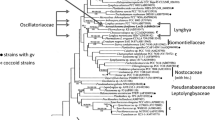Abstract
The criteria for cyanobacterial taxonomy have changed substantially in the last several years. The most important of the newly introduced methods are molecular sequencing and the genetic approach, which is considered as a major criterion for the classification of organisms. However, molecular results have not always been in agreement with those of the traditional classification system based on morphological or ecological criteria. Thus, application of the polyphasic approach provides the best means of conducting taxonomic practice, and the coincidences and correlations of various criteria must be discovered. Here are discussed the main problems associated with the taxonomy of simple, relatively wide filamentous cyanobacteria with short vegetative cells, but without prominent cells (heterocytes, akinetes). Examples were selected from the family Oscillatoriaceae, which was traditionally based only on morphological criteria. The main markers for delimitation of this family after revisions and the relations and consequences of various genera are discussed, as well as a proposal to base the final revision of this family according to modern criteria. The members of this cyanobacterial group are distributed in numerous ecosystems around the world and form also distinct communities in tropical America.




Similar content being viewed by others
References
Anagnostidis K, Komárek J (1988) Modern approach to the classification system of cyanophytes 3—Oscillatoriales. Algol Stud 50–53:327–472
Ballot A, Dadheech PK, Krienitz L (2004) Phylogenetic relationship of Arthrospira, Phormidium and Spirulina strains from Kenyan and Indian waterbodies. Algol Stud 113:37–56
Dvořák P (2017) Genome-wide analysis of cyanobacterial evolution: the example of Synechococcus. In: Los DA (ed) Cyanobacterial omics and manipulation. Caister Academic Press, Poole, pp 35–53
Elenkin AA (1938) Monographia algarum cyanophycearum aquidulcium et terrestrium in finibus USSR inventarum. [Sinezelenye vodorosli SSSR]. Izd AN SSSR, Moskva-Leningrad 1,2: 1-1908
Fjerdingstad E, Holma B, Fjerdingstad EJ (1976) The structure of Oscillatoria limosa AG. (Cyanophyceae) and the formation of hormogonia and necridia. Rev Algol NS 11:261–272
Geitler NL (1932) Cyanophyceae. In: Rabenhorst’s Kryptogamenflora von Deutschland, Österreich und der Schweiz. Akad Verlagsges, Leipzig
Komárek J, Kaštovský K (2003) Coincidences of structural and molecular characters in evolutionary lines of cyanobacteria. Algol Stud 109:305–325
Komárek J, Kaštovský J, Mareš J, Johansen JR (2014) Taxonomic classification of cyanoprokaryotes (cyanobacterial genera) 2014, using a polyphasic approach. Preslia 86:295–335
Lang NJ, Whitton BA (1973) Arrangement and structure of thylakoids. In: Carr NG, Whitton BA (eds) The biology of blue green algae. Blackwell, London, pp 66–79
Malone CFS, Rigonato J, Laughinghouse HD IV, Schmidt EC, Buzon ZL, Wilmotte A, Fiore FM, Sant’Anna CL (2015) Cephalothrix gen. nov. (Cyanobacteria): towards an intraspecific phylogenetic evaluation by multilocus analyses. IJSEM 65:2993–3007
Moro I, Di Bella M, Rascio N, LaRocca N, Andreoli C (2007) Conferva duplisecta Pollini: rediscovery in Euganean thermal spring (Italy) and new assignment to the Oscillatoria genus. Caryologia 60:133–136
Rippka R, Waterbury JB, Stanier RY (1981) Provisional generic assignments of cyanobacteria in pure culture. In: Starr MP, Stolp H, Trüper HC, Balows A, Schlegel HG (eds) The prokaryotes, vol 1. Springer, Berlin, pp 247–256
Sciuto K, Andreoli C, Rascio N, La Rocca N, Moro I (2012) Polyphasic approach and typification of selected Phormidium strains (Cyanobacteria). Cladistics 28:357–374
Starmach K (1966) Cyanophyta—sinice. Flora Slodkow Polski, Panstw Wyd Nauk, Krakow
Watanabe M, Komárek J (1989) New Blennothrix-species (Cyanophyceae/Cyanobacteria) from Nepal. Bull Natl Sci Mus Ser B Tokyo 15:67–79
Wehr JD, Sheath RG, Kociolek JP (2015) Freshwater algae of North America, 2nd edn. Academic Press, Elsevier, London
Acknowledgements
This study was elaborated under the support of the Grant No. GA15-00113S. To the results of this study were derived numerous details from previous published studies, from which were selected several results supporting the presented data. I thank therefore to all colleagues, who helped by their work to the solution of problematics of the modern characterization of family Oscillatoriaceae. I thank particularly to O. Strunecký for the molecular evaluation of studied Oscillatoria strains, to J. Šmarda for the original photos of ultrathin sections of several cyanobacterial filaments and to D. Švehlová for the technical preparation of the manuscript.
Author information
Authors and Affiliations
Corresponding author
Rights and permissions
About this article
Cite this article
Komárek, J. Delimitation of the family Oscillatoriaceae (Cyanobacteria) according to the modern polyphasic approach (introductory review). Braz. J. Bot 41, 449–456 (2018). https://doi.org/10.1007/s40415-017-0415-y
Received:
Accepted:
Published:
Issue Date:
DOI: https://doi.org/10.1007/s40415-017-0415-y




